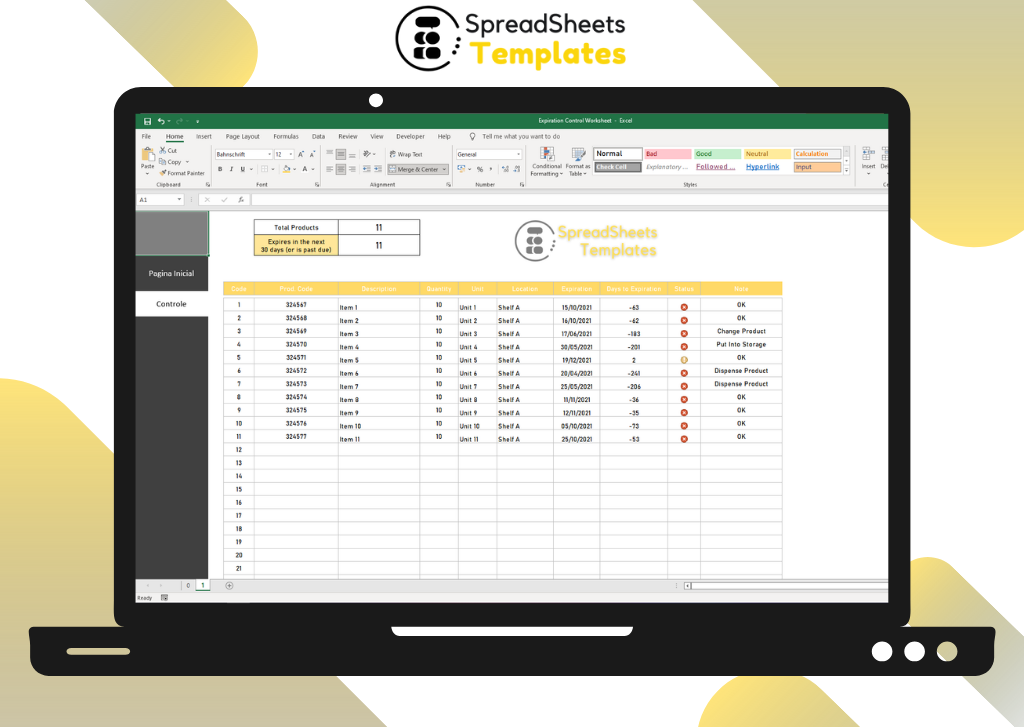Expiration Control Worksheet Leave a comment
Managing Your Time and Resources Effectively
Introduction
In the fast-paced world we live in, managing time and resources efficiently is crucial for success. Whether you’re a business owner, a project manager, or an individual trying to stay organized, the Expiration Control Worksheet can be a valuable tool to help you stay on top of your tasks and deadlines. This article will explore the concept of the Expiration Control Worksheet and provide insights on how to utilize it effectively.
What is an Expiration Control Worksheet?
An Expiration Control Worksheet is a structured document designed to help individuals and organizations manage their time, tasks, and resources. It serves as a central hub where you can track important deadlines, prioritize tasks, allocate resources, and monitor progress. By utilizing an Expiration Control Worksheet, you can gain better control over your commitments and ensure that nothing falls through the cracks.
Benefits of Using an Expiration Control Worksheet
1. Enhanced Time Management
With an Expiration Control Worksheet, you can break down your tasks into manageable units and assign realistic deadlines. This enables you to prioritize effectively, ensuring that time is allocated to the most important tasks. By having a clear overview of your schedule, you can make informed decisions about how to best utilize your time and avoid unnecessary delays.
2. Improved Resource Allocation
Efficient resource allocation is essential for achieving optimal results. An Expiration Control Worksheet allows you to identify the resources required for each task and allocate them accordingly. Whether it’s manpower, finances, or equipment, having a systematic approach to resource allocation ensures that you make the most out of what you have.
3. Minimized Errors and Oversights
Human errors and oversights can be costly, both in terms of time and money. The Expiration Control Worksheet acts as a safety net, reducing the chances of overlooking important deadlines or tasks. By having all the information in one place, you can easily spot any potential issues and take corrective action before it’s too late.
4. Increased Accountability
When you have a structured system in place, it becomes easier to hold yourself and others accountable. The Expiration Control Worksheet allows you to assign responsibilities and track progress, ensuring that everyone involved understands their roles and contributes to the overall success of the project.
How to Create an Expiration Control Worksheet
Now that we understand the benefits of using an Expiration Control Worksheet, let’s dive into the process of creating one.
Step 1: Define Your Goals and Objectives
Start by clearly defining your goals and objectives. What do you want to achieve with the Expiration Control Worksheet? Are you managing a project, organizing personal tasks, or overseeing a team? Understanding your specific needs will help you structure the worksheet accordingly.
Step 2: Identify Key Deadlines and Milestones
Identify the key deadlines and milestones associated with your project or tasks. These could be project completion dates, important meetings, or deliverable due dates. By highlighting these dates, you’ll have a clear sense of the timeline you’re working with.
Step 3: Break Down Tasks and Subtasks
Break down your tasks into smaller, more manageable units. This will make it easier to allocate time, resources, and track progress. Use subheadings and bullet points to clearly outline each task and its subtasks.
Step 4: Allocate Resources
Identify the resources required for each task. This may include personnel, budget, equipment, or any other necessary resources. Assign resources to each task to ensure that you have everything you need to complete it successfully.
Step 5: Set Priorities
Prioritize your tasks based on their importance and urgency. Assign deadlines to each task and subtask, considering dependencies and the overall project timeline. This will help you stay focused and ensure that you tackle the most critical tasks first.
Step 6: Monitor Progress and Adjust as Needed
Regularly review and update your Expiration Control Worksheet to track progress. Make adjustments as needed, taking into account any unforeseen circumstances or changes in priorities. By keeping your worksheet up to date, you’ll have a clear view of the progress you’re making and can make informed decisions accordingly.
Frequently Asked Questions (FAQs)
1. How can an Expiration Control Worksheet help me manage my personal tasks?
An Expiration Control Worksheet is not limited to professional projects; it can be equally beneficial for managing personal tasks. By utilizing this tool, you can prioritize your personal commitments, set deadlines, and allocate resources effectively. It helps you stay organized and ensures that you have a clear plan in place to accomplish your goals.
2. Can I use digital tools or software to create an Expiration Control Worksheet?
Absolutely! In fact, using digital tools or specialized project management software can enhance the effectiveness of your Expiration Control Worksheet. These tools often provide additional features like automated notifications, progress tracking, and collaboration capabilities, making it easier to manage complex projects or team-based tasks.
3. How frequently should I update my Expiration Control Worksheet?
The frequency of updates depends on the nature of your tasks or projects. As a general guideline, aim to review and update your Expiration Control Worksheet at least once a week. This ensures that you stay on top of any changes, adjust priorities if needed, and keep your stakeholders informed.
4. Can I share my Expiration Control Worksheet with others?
Yes, sharing your Expiration Control Worksheet can foster collaboration and ensure everyone involved is on the same page. Whether you’re working with a team or seeking feedback from stakeholders, sharing the worksheet allows for transparency and accountability.
5. What are some common challenges in using an Expiration Control Worksheet?
Some common challenges include accurately estimating task durations, managing unexpected changes or delays, and balancing competing priorities. However, with regular practice and experience, you’ll become more adept at navigating these challenges and leveraging the Expiration Control Worksheet effectively.
6. Are there any alternative methods for managing tasks and deadlines?
While the Expiration Control Worksheet is a powerful tool, different individuals and organizations may have unique preferences or requirements. Some alternative methods include using digital calendars, project management software, or even traditional pen-and-paper planners. The key is to find a system that suits your needs and allows you to stay organized and in control.
Conclusion
In conclusion, the Expiration Control Worksheet is a valuable resource for managing time, tasks, and resources effectively. By utilizing this tool, you can enhance your time management skills, allocate resources efficiently, minimize errors, and increase accountability. Whether you’re working on personal tasks or complex projects, the Expiration Control Worksheet provides a structured approach to stay organized and achieve your goals.
Remember, success lies in the details, and the Expiration Control Worksheet empowers you to pay attention to those details. So start implementing this powerful tool today and unlock your true potential!


